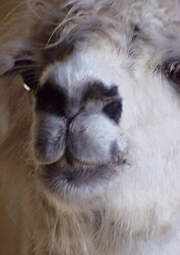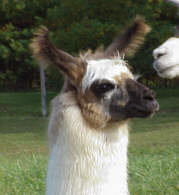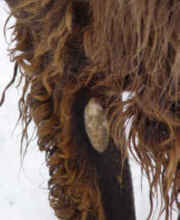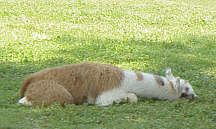|
Home
Herd
Sires
Dams
For
Sale
Cappy's
Place
About
Llamas
Vet
Corner
Barnyard
Hints
Fun
& Games
Over The
Fence
Llama Talk
Youth
& 4-H
Events
Links
Books
Contact
All
American
Youth
Jamboree
|
|
Llamas have quite a dignified manner and because of their
extreme curiousity, have a delightful habit of coming close
and leaning over to sniff - just to see what's going on. They
are highly social herd animals and need the companionship
of another llama or grazing livestock. Under normal conditions,
llamas will not bite, kick, or spit, but are gentle and well-behaved.
Only one exception to this rule is that if a male has been over
handled or bottle fed improperly during his young years, he may
possibly develop some aggressive behavior which can be quite
dangerous when he is an adult. It is not adviseable to purchase
a young animal that has more interest in humans than in the herd.
and that is very friendly. More about male behaviors. |

|
Mature by age four, llamas weigh an average of 250 to 500
pounds and have a lifespan of 15 to 20 years. Their upper lip
is split, (called prehensile) enabling them to pick up small pieces
of grass, sticks, or leaves as they browse. With only lower
teeth in the front, they do not bite people or predators. There
are grinding molars on the top and bottom jaw in the back for
chewing. Adult males develop six pointed fighting teeth, three on each side, which
can efficiently be used in a ripping fashion. In domestic herds,
these six teeth should be removed for safety. More about
fighting teeth. |
|
Their split-toed foot has a hard nail on each of the two toes
and a soft pad on the bottom of the foot. This structure
allows llamas to be very quiet, agile and sure-footed and
they have a low impact on the environment. Their toenails need to
be trimmed periodically as routine management. More about
trimming toenails.
|

|

|
Llamas communicate by a series of gentle hums and ear
and tail movements. They have a keen sense of hearing and
sight. Llama's ears are long and hooked and can turn independently
of each other as they pick up sounds from all directions. When
danger is in the area, they give an unusual high pitched alarm
call - it almost sounds similar to a tropical bird.
Ears up tall and forward indicates interest and curiosity. Ears
laid back may indicate apprehensiveness to something new. |
|
When totally relaxing and chewing their cud, their ears are also
often laid back. Many think that laid back ears is a sign that
they intend to spit, but that is not often the case. When threatening
to spit, the ears will be laid back and the head will be held high
pointed into the air as they posture trying to make themselves
look tall - a body position that cannot be missed. |
|
Posturing stretched very tall with their head held high, usually with
their tail rapidly flipping, indicates a standoffish displeasure. This
behavior is usually given by a pregnant female when a male starts to
approach her. Accompanied by a clucking sound in her throat, she
warns the male that she is not receptive and has no intention of giving
him a second look. If he continues to pursue her, he will be given a
firmer "no" accompanied with green spit. |
Spitting is the llama's unique way of self defense, however they
normally do not spit at people unless they have been mistreated
or are objecting to a something hurtful. Llamas use spitting as a
means of communication with others in their herd and it can often
just be a warning spray into the air as they show their dominance
over a food dish, discipline the young crias, or indicate their pecking
order in the herd. When seriously aggrevated, the spit consists of
regurgitated grass rumen and has a very foul odor. Although the spit
may come surprisingly sudden, it is far less painless than a dog bite.
When spitting occurs within the herd, it results in a sour mouth for
both participants. Both animals end up with their mouth hanging open
and the lower lip loosely hanging as if disjointed. Accompanied by
drooling, this will last 15 to 20 minutes and they will be unable to eat
during this time. They usually like to hold some hay or a leaf in their
mouth to sweeten things up. |
|
Within the llama's pasture, you will be able to find one or more dust
bowls constructed by the animals. Pawing at it with their toe nails,
they create a very fine bed of dust where they love to roll. This daily
dust bath is thought to help keep their fibers separated. Whatever it
does, it certainly feels good to them and they love to roll ! |

|
|
A modified ruminant, llamas chew their cud when relaxed. Often a
bulge in the side cheek area may be seen as they store their next
wad of cud. More than one new llama owner has been alarmed when
first observing this bulge thinking that it is a huge abscess on the jaw. |

|
On the lower, outside of the rear legs, there is an oval, hairless spot
called the chestnut or scent gland. The proper name is the metatarsal
gland which may help in regulating the animal's body temperature.
Actually, it's purpose is not well understood. Often this spot is alarming
when noticed by new owners as it may appear that the animal has a
wound on his leg. The gland on the inner surface of the rear leg is the
tarsal gland and serves to identify individuals.
|
|
Another habit they practice as a way of alarming their new owners is to
sun bathe on the hottest days. They lay out on their side or back with
their belly facing the sun and you can hardly detect even a small ear
movement. It's only after you run out to them, completely sure that
they have just died, that they will look up at you with that wide eyed,
innocent surprised look. |

|

|
When laying down, the llama is in an unusual kushed position. All four
legs are tucked under and out of sight. This most likely is a trait that
helps protect them from predators. Llamas normally do not like their heads
or legs touched or held and will pull away. Since they are a prey animal,
their legs are their main means of self defense as they can run and jump
as swiftly as a deer.
|
When sleeping, they will sometimes lay their head
straight out on the ground.
The length of llama wool varies from 3 to 10 inches on an adult,
yielding from 3 to 4 pounds of wool per year. The texture of the
llama's coat also varies from one with guard hairs and a thick
undercoat to a single coated silky wool. Upon close investigation,
you can see a fine crimp, just like an elastic zig-zag, in each
individual hair which gives memory to the wool when spinning.
Colors also greatly vary. Ranging from black to white, grays, browns,
and reds, variety further continues with beautiful patterns from
paints, appaloosas, and solids. |
© 1996/2018 Shagbark Ridge Llamas

Thank you for visiting Hamilton Co. Llamas, Inc. If you have
questions or comments, please leave a message.
|
|

